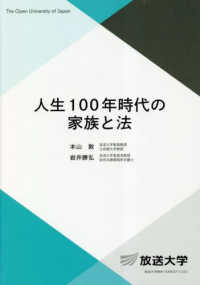Full Description
This Value Pack consists of the Learn to Listen, Listen to Learn 2 Student Book and the Classroom Audio CD.
The newly expanded Learn to Listen, Listen to Learn series prepares students for the rigors of academic classwork, helping them acquire the listening-comprehension and note-taking skills necessary for success.
This two-book series offers students valuable tips for getting the most from college lectures, including note-taking skills, organization of information, recognition of language cues, and the acquisition of vocabulary. Students are shown how a typical lecture is organized, using extensive excerpts and transcripts from authentic lectures on high-interest topics from a wide range of academic discipline.
Features:
Includes new and updated material, including expanded vocabulary, extension, and post-lecture activities to encourage students to discuss, research, and write about ideas raised in the lectures.
Teaches students how to recognize lecture organization, and how to evaluate and predict information.
Focuses on the acquisition of vocabulary, especially from the Academic Word List, and on the recognition of language cues.
Prepares students for academic testing with TOEFL-style test questions throughout the text.
See also Learn to Listen, Listen to Learn 1.
Contents
UNIT 1 STARTING OUT: PRE-COURSEWORK EVALUATION
A. Evaluating Listening Comprehension and Note-Taking Skills
LECTURE 1: Academic Listening (Linguistics)
B. Teacher's Note-Taking Feedback Form
C. Student's Goal-Setting Form
UNIT 2 THE STRUCTURE OF A LECTURE
A. Comparing the Language of Lecturing to the Language of Writing
B. Noticing Lecture Structure and Cues
C. Understanding the Role of Paraphrase, Repetition, Exemplification, and Digression
D. Key Differences between the Language of Lecturing and
the Language of Writing
E. Using Context and Prediction to Get Main Ideas
F. Predicting Content and Lecture Direction
UNIT 3 USING INTRODUCTIONS, CONCLUSIONS, AND DIGRESSIONS
A. Understanding Lecture Focus and Direction from Introductions
B. Using Conclusions to Check the Lecture's Main Points
C. Digressions
UNIT 4 NOTE-TAKING BASICS
A. Recognizing and Using Key Words
B. Making Abbreviations Work for You
C. Using Note-Taking Symbols and Abbreviations
D. Visually Representing Relationships and the Relative Importance
of Information
LECTURE 2: Women and Work (Sociology)
E. Note-Taking Practice
F. Eight DOs and DON'Ts for Improving Lecture Comprehension
and Note-Taking
UNIT 5 NOTING NUMBERS AND STATISTICS EFFECTIVELY
A. Numbers: A Review
LECTURE 3: Milestones in Technology (History/Technology)
LECTURE 4: Immigration to the United States (History/Sociology)
UNIT 6 LISTENING FOR ORGANIZATION (PART 1)
A. Understanding the Importance of Recognizing Lecture Organization
B. Recognizing Organizational Plans within Lectures
C. Defining Terms through Simple and Extended Definitions
D. Listing Subtopics
E. Exemplifying a Topic
LECTURE 5: Amnesty International (Political Science/Management)
LECTURE 6: Two 21st Century Eco-Heroes (Ecology)
UNIT 7 LISTENING FOR ORGANIZATION (PART 2)
A. Describing Characteristics
B. Describing a Process or Sequence of Events
C. Classifying Subtopics
LECTURE 7: Paging Robodoc: Robots in Medicine (Biology/Technology)
LECTURE 8: How to Look at Art (Art)
UNIT 8 LISTENING FOR ORGANIZATION (PART 3)
A. Describing a Causal Relationship
B. Comparing and Contrasting
C. Recognizing Generalizations and their Support
LECTURE 9: Hall's Classification of Cultures (Sociology)
LECTURE 10:Earthquakes: Can They Be Predicted? (Geology)
UNIT 9 TYING IT TOGETHER: END-OF-COURSE EVALUATION
LECTURE 11: Perfectionism (Psychology)
LECTURE 12: High-Tech Harvesting: Hope or Horror? (Agriculture/Ecology/Biology)
Appendix A Academic Word List Vocabulary
Appendix B Lecture Index by Organizational Plan
Appendix C Lecture Index by Subject Matter
Appendix D Rewritten Notes for Lectures








